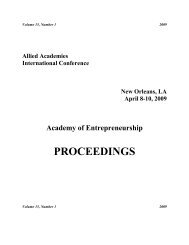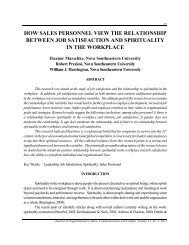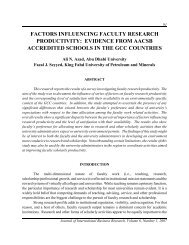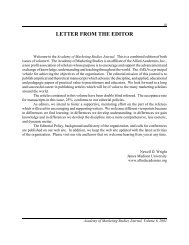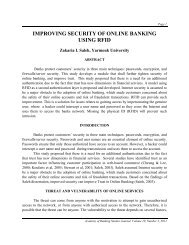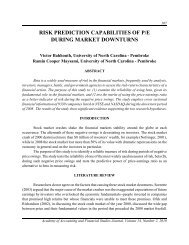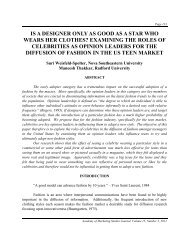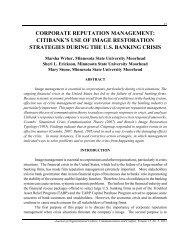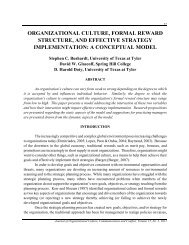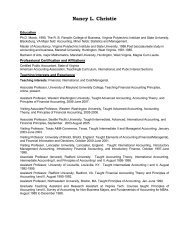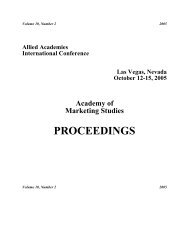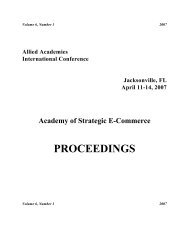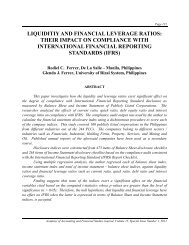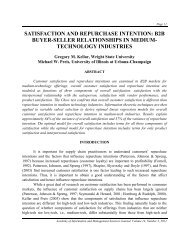Academy of Marketing Studies - Allied Academies
Academy of Marketing Studies - Allied Academies
Academy of Marketing Studies - Allied Academies
- No tags were found...
Create successful ePaper yourself
Turn your PDF publications into a flip-book with our unique Google optimized e-Paper software.
Volume 17, Number 2 ISSN 2150-5187<br />
<strong>Allied</strong> <strong>Academies</strong><br />
International Conference<br />
Las Vegas, Nevada<br />
October 10-13, 2012<br />
<strong>Academy</strong> <strong>of</strong><br />
<strong>Marketing</strong> <strong>Studies</strong><br />
PROCEEDINGS<br />
Copyright 2012by the DreamCatchers Group, LLC, Arden, NC, USA
Page ii<br />
<strong>Allied</strong> <strong>Academies</strong> International Conference<br />
All authors execute a publication permission agreement taking sole responsibility for the<br />
information in the manuscript. The DreamCatchers Group, LLC is not responsible for the<br />
content <strong>of</strong> any individual manuscripts. Any omissions or errors are the sole responsibility <strong>of</strong> the<br />
individual authors.<br />
The <strong>Academy</strong> <strong>of</strong> <strong>Marketing</strong> <strong>Studies</strong> Proceedings is owned and published by the DreamCatchers<br />
Group, LLC, PO Box 1708, Arden, NC 28704, U.S.A., (828) 507-9770. Those interested in the<br />
Proceedings, or communicating with the Proceedings, should contact the Executive Director <strong>of</strong><br />
the <strong>Allied</strong> <strong>Academies</strong> at info@alliedacademies.org.<br />
Copyright 2012 by the DreamCatchers Group, LLC, Arden, NC<br />
Proceedings <strong>of</strong> <strong>Academy</strong> <strong>of</strong> <strong>Marketing</strong> <strong>Studies</strong>, Volume 17, Number 2, 2012
<strong>Allied</strong> <strong>Academies</strong> International Conference<br />
Table <strong>of</strong> Contents<br />
Page iii<br />
ARE NEW MARKETING PROFESSORS<br />
READY TO TEACH .................................................................................................................. 1<br />
Timothy C. Johnston, Murray State University<br />
Martin Milkman, Murray State University<br />
James McCoy, Murray State University<br />
MEASURNG HOTEL SERVICE QUALITY PERCEPTIONS:<br />
THE DISPARITY BETWEEN COMMENT CARDS AND LODGSERV ............................. 7<br />
Nancy K. Keith, Missouri State University<br />
Christina S. Simmers, Missouri State University<br />
STREAMLINING THE MANAGEMENT AND GOVERNANCE OF<br />
E-GOVERNMENT PROCESSES: A DIGITAL COLLABORATIVE<br />
APPROACH FOR DEVELOPMENT APPROVAL ................................................................. 9<br />
Anupam Nath, Elizabeth City State University<br />
Elizabeth City State University<br />
Elizabeth City State University<br />
SALESLPERSON PERFORMANCE: EXPLORING THE ROLES OF ROLE<br />
AMBIGUITY, AUTONOMY AND SELF-EFFICACY .......................................................... 15<br />
Charles E. Pettijohn, Missouri State University<br />
Allen D. Schaefer, Missouri State University<br />
Melissa S. Burnett, Missouri State University<br />
ETHICS AND MARKETING ................................................................................................... 17<br />
Austin Doerr, Indiana Wesleyan University<br />
Beth Sheaffer, Indiana Wesleyan University<br />
Proceedings <strong>of</strong> <strong>Academy</strong> <strong>of</strong> <strong>Marketing</strong> <strong>Studies</strong>, Volume 17, Number 2, 2012
Page iv<br />
<strong>Allied</strong> <strong>Academies</strong> International Conference<br />
Proceedings <strong>of</strong> <strong>Academy</strong> <strong>of</strong> <strong>Marketing</strong> <strong>Studies</strong>, Volume 17, Number 2, 2012
<strong>Allied</strong> <strong>Academies</strong> International Conference Page 1<br />
ARE NEW MARKETING PROFESSORS<br />
READY TO TEACH<br />
Timothy C. Johnston, Murray State University<br />
Martin Milkman, Murray State University<br />
James McCoy, Murray State University<br />
ABSTRACT<br />
This research found that most early-career marketing pr<strong>of</strong>essors surveyed (94%) had the<br />
opportunity to teach a full course and/or recitation sections while in their doctoral programs.<br />
On-the-job teacher training for doctoral students continues to be widely available, with an<br />
increased level <strong>of</strong> responsibility over courses. Only 58% <strong>of</strong> doctoral students participated in<br />
formal teacher training, including for-credit and/or non-credit programs. Only 31% <strong>of</strong><br />
respondents participated in any for-credit teacher preparation training program. Respondents<br />
with marketing doctoral teacher training rated their preparation for teaching as “good” on<br />
average, also reported a slightly higher level <strong>of</strong> enthusiasm for teaching. Future research may<br />
consider additional questions about teacher training. What is the role <strong>of</strong> marketing doctoral<br />
teacher training outside <strong>of</strong> formal courses or programs, such as faculty mentoring What is the<br />
role <strong>of</strong> early-career teacher training to remediate a lack <strong>of</strong> doctoral program training<br />
<strong>Marketing</strong> doctoral teaching training has increased, to the benefit <strong>of</strong> early-career pr<strong>of</strong>essors; yet<br />
the over 40% <strong>of</strong> pr<strong>of</strong>essors who lack formal training suggests that there is more to be done.<br />
INTRODUCTION<br />
Research by Griffith (1997), Butler, Laumer & Moore (1994), Madhavaram & Laverie<br />
(2010) and others has concluded that doctoral teacher training efforts, specifically for marketing<br />
educators, are needed and have fallen short in the past. The need for marketing doctoral teaching<br />
training is important for early-career pr<strong>of</strong>essors who wish to be successful in the pr<strong>of</strong>ession, as<br />
well as pr<strong>of</strong>essors in doctoral programs whose responsibility it is to train future teachers.<br />
This paper looks at the current state <strong>of</strong> teacher training in doctoral programs as reported<br />
by recent marketing doctoral graduates who are working in the academy. We begin by<br />
discussing the methodology <strong>of</strong> the survey and describing the sample. We conclude with results<br />
<strong>of</strong> (1) the degree <strong>of</strong> teaching and teacher training encountered by pr<strong>of</strong>essors in their doctoral<br />
programs, and (2) the pr<strong>of</strong>essors’ perceptions <strong>of</strong> their teaching preparation and performance.<br />
METHODOLOGY<br />
We conducted a survey to explore how recent marketing doctoral recipients (including<br />
ABDs) perceived the pedagogical training they received during their doctoral programs. The list<br />
Proceedings <strong>of</strong> <strong>Academy</strong> <strong>of</strong> <strong>Marketing</strong> <strong>Studies</strong>, Volume 17, Number 2, 2012
Page 2<br />
<strong>Allied</strong> <strong>Academies</strong> International Conference<br />
<strong>of</strong> 500 graduates from 60 universities gleaned from Who Went Where (DocSIG, n.d.) surveys is<br />
a significant proportion <strong>of</strong> the total population <strong>of</strong> marketing doctoral graduates for the years<br />
2006-2010.<br />
We received usable responses from a total <strong>of</strong> 96 people, a response rate <strong>of</strong> about 19<br />
percent. Survey respondents (n=96) were mostly male (67%) native-English speakers (67%)<br />
with mean age <strong>of</strong> 36 years. All were PhD graduates (or ABD) in years 2006 – 2010 from U.S.<br />
universities (80%) and had been working for an average <strong>of</strong> 2.9 years in tenure-track (95%)<br />
positions at U.S. universities (60%).<br />
Teaching Experience<br />
RESULTS<br />
Ninety-four percent <strong>of</strong> our respondents reported having teaching and/or teaching<br />
assistantship responsibilities during their doctoral program (Table 2). This is consistent with<br />
Griffith’s (1997) survey <strong>of</strong> marketing doctoral students that found 41 <strong>of</strong> 44 respondents (93%)<br />
had teaching responsibilities. In economics, McCoy & Milkman (2010) reported that 96% <strong>of</strong><br />
respondents in a survey <strong>of</strong> recent PhD graduates had teaching and/or teaching assistantship<br />
duties.<br />
Eighty-seven percent taught stand-alone courses (full course responsibility) during their<br />
doctoral program, with an average 4 classes per respondent. This is substantially higher than the<br />
result reported in Griffith (1997) that 75% <strong>of</strong> doctoral student respondents had full teaching<br />
responsibility in their courses. McCoy & Milkman (2010) also reported that 75% <strong>of</strong> economics<br />
PhDs taught stand-alone courses in graduate school.<br />
Teacher Training<br />
Thirty <strong>of</strong> the respondents (31%) responded “yes” to the question: “During your doctoral<br />
program, did you attend a graduate credit course on undergraduate teaching. Most graduate<br />
courses on undergraduate teaching awarded three semester hours <strong>of</strong> credit.<br />
The levels <strong>of</strong> for-credit marketing doctoral teacher training found in this research were<br />
much higher than in previous studies. Griffith (1997) found that only 11% <strong>of</strong> respondents<br />
reported completing pedagogical course work. In economics, McCoy & Milkman (2010)<br />
reported that 12% <strong>of</strong> respondents in a survey <strong>of</strong> recent PhD graduates had taken a graduate credit<br />
course on undergraduate teaching.<br />
Respondents who completed a graduate course on teaching also responded to the<br />
question: “How well did this graduate credit course prepare you for teaching” The average<br />
response was 3.4 on a scale <strong>of</strong> one (very poorly) to five (very well). No person rated the course<br />
“very poorly.”<br />
Slightly more respondents participated in a non-credit teaching training program (34%)<br />
than in a for-credit teaching course (31%). The larger proportion <strong>of</strong> non-credit courses found<br />
was consistent with earlier results—36% in Griffith (1997)—and in the economics literature<br />
Proceedings <strong>of</strong> <strong>Academy</strong> <strong>of</strong> <strong>Marketing</strong> <strong>Studies</strong>, Volume 17, Number 2, 2012
<strong>Allied</strong> <strong>Academies</strong> International Conference Page 3<br />
(Walstad & Becker, 2003; McCoy & Milkman, 2010). The non-credit programs attended by our<br />
respondents averaged about 14.6 total contact hours with a minimum <strong>of</strong> 3 contact hours and a<br />
maximum <strong>of</strong> 30 contact hours.<br />
Overall 56 <strong>of</strong> 97 respondents (58%) participated in a for-credit teaching course, a noncredit<br />
teaching course, or both. These respondents are hereafter referred to as “trained.” The<br />
proportion <strong>of</strong> doctoral students who received formal teacher training was consistent with earlier<br />
results in the economics literature (Walstad & Becker, 2003). In particular, McCoy & Milkman<br />
(2010) round that 52% <strong>of</strong> respondents who taught a stand-alone course during their doctoral<br />
programs had formal teacher preparation training (for credit or noncredit).<br />
Teaching Preparation and Performance<br />
All respondents were next asked, “Overall, how well prepared for teaching were you at<br />
the completion <strong>of</strong> your doctoral program” Again using the 5-point scale previously described<br />
(very poor to very well), the average response was 3.7. The mean response <strong>of</strong> those who had no<br />
training was 3.5, which was lower than the mean <strong>of</strong> those who had training (credit or non-credit)<br />
at 3.9 (Table 3). The difference between means was significant at the P = 0.17 level, according<br />
to a 2-tailed t-test.<br />
We asked respondents “Please rate the level <strong>of</strong> your enthusiasm for teaching.” The 5-<br />
point scale for both questions was “very enthusiastic” being a 5 and “very unenthusiastic” being<br />
a 1. The mean response was “enthusiastic to very enthusiastic” for pr<strong>of</strong>essors who had pedagogy<br />
training in their doctoral program (4.3) and for those who did not have training (4.2).<br />
We also asked respondents to self-report “how do your students rate you as a<br />
college/university teacher” The 5-point scale for both questions was “very good” being a 5 and<br />
“very poor” being a 1. The mean response was “good to very good” for both pr<strong>of</strong>essors who had<br />
pedagogy training in their doctoral program (4.4) and surprisingly higher for those who did not<br />
have training (4.5).<br />
Respondents were asked “Please rate yourself as a college/university teacher.” The mean<br />
response was “good to very good” for pr<strong>of</strong>essors who had pedagogy training in their doctoral<br />
program (4.2) and again surprisingly higher for those who did not have training (4.4).<br />
Perhaps the “head start” in teaching preparation enjoyed by the trained teachers<br />
diminishes during the first few years in the pr<strong>of</strong>ession, such that early-career pr<strong>of</strong>essors are<br />
comfortable and performing well after some time on the job. The extent <strong>of</strong> dropout bias in the<br />
data due to unsuccessful pr<strong>of</strong>essors leaving academia and hence not responding to the survey is<br />
not known.<br />
While the means for self-reported “student ratings” and “self-ratings” was higher for<br />
untrained teachers than for trained teachers, the differences were not statistically significant.<br />
Regarding the statistical tests, the selection <strong>of</strong> respondents to the sample, and the assignment <strong>of</strong><br />
respondents to treatment groups, was not random. Since respondents first chose to respond to<br />
the “Who Went Where” survey, and later chose to respond to the research survey, one could<br />
speculate that a positive bias toward enthusiastic and successful academics would result.<br />
Proceedings <strong>of</strong> <strong>Academy</strong> <strong>of</strong> <strong>Marketing</strong> <strong>Studies</strong>, Volume 17, Number 2, 2012
Page 4<br />
<strong>Allied</strong> <strong>Academies</strong> International Conference<br />
SUMMARY<br />
This research found that most marketing doctoral students (94%) had the opportunity to<br />
teach a full course and/or recitation sections while in their doctoral programs. Respondents<br />
reported taking full responsibility for a course in graduate school at a higher proportion (87%)<br />
than respondents to the Griffith (1997) survey (75%). On-the-job teacher training for doctoral<br />
students continues to be widely available, with an increased level <strong>of</strong> responsibility over courses.<br />
Not all doctoral-program teachers received formal training, however. While the<br />
proportion <strong>of</strong> graduate-student teachers who received formal training has risen, it still leaves over<br />
40% <strong>of</strong> early-career marketing pr<strong>of</strong>essors to learn their teaching skills with on-the-job experience<br />
or informal faculty mentoring. The stress experienced by early-career marketing pr<strong>of</strong>essors and<br />
the frustration <strong>of</strong> their students are two potential consequences <strong>of</strong> relying on on-the-job teaching<br />
training.<br />
Only 31% <strong>of</strong> respondents participated in any for-credit teacher preparation training<br />
program. While this level shows that the integration <strong>of</strong> marketing teaching training into the<br />
doctoral program is far from universal, it is practiced to a much greater extent that the 11% <strong>of</strong><br />
doctoral students who reported completing a pedagogy course in Griffith’s (1997) study. This<br />
shows that the teaching role <strong>of</strong> the marketing pr<strong>of</strong>essor still lacks emphasis in the academic core<br />
<strong>of</strong> marketing doctoral programs.<br />
Respondents with marketing doctoral teacher training rated their preparation for teaching<br />
as “good” on average, whereas respondents with no formal training rated their preparation as<br />
“adequate to good.” Trained teachers also reported a slightly higher level <strong>of</strong> enthusiasm for<br />
teaching, although both trained and untrained teachers rated their enthusiasm highly. One could<br />
speculate that marketing students may have benefited from the confidence and enthusiasm <strong>of</strong> the<br />
trained pr<strong>of</strong>essors.<br />
The availability <strong>of</strong> marketing doctoral teacher training has increased, and increasingly<br />
consists <strong>of</strong> graduate credit courses that are required by the doctoral program. Future research<br />
may consider additional questions about teacher training. What is the role <strong>of</strong> marketing doctoral<br />
teacher training outside <strong>of</strong> formal courses or programs, such as faculty mentoring What is the<br />
role <strong>of</strong> early-career teacher training to remediate a lack <strong>of</strong> doctoral program training What is<br />
the impact <strong>of</strong> doctoral teacher training on non-native English speakers who teach in U.S.<br />
universities <strong>Marketing</strong> doctoral teaching training has increased, to the benefit <strong>of</strong> early-career<br />
pr<strong>of</strong>essors; yet the over 40% <strong>of</strong> pr<strong>of</strong>essors who are lack formal training suggests that there is<br />
more to be done.<br />
REFERENCES<br />
AMA Task Force (1988) on the Development <strong>of</strong> <strong>Marketing</strong> Thought. Developing, Disseminating, and Utilizing<br />
<strong>Marketing</strong> Knowledge. Journal <strong>of</strong> <strong>Marketing</strong>, 52:4 (Oct.), 1-25. Accessed September 12, 2012 at<br />
http://www.jstor.org/stable/1251631 .<br />
Butler, Daniel D., J. Ford Laumer, Jr., & Matt Moore (1994). Graduate teaching assistants: Are business schools<br />
focusing on increasing teaching excellence <strong>Marketing</strong> Education Review, 4(2), 14-19.<br />
Proceedings <strong>of</strong> <strong>Academy</strong> <strong>of</strong> <strong>Marketing</strong> <strong>Studies</strong>, Volume 17, Number 2, 2012
<strong>Allied</strong> <strong>Academies</strong> International Conference Page 5<br />
DocSIG (n.d.). “Who Went Where and Salary Surveys. American <strong>Marketing</strong> Association Doctoral Students Special<br />
Interest Group, retrieved March 5, 2012 at http://www.docsig.org/index.php/recent/who-went-where-andsalary-surveys<br />
Griffith, David A. (1997). An Examination <strong>of</strong> <strong>Marketing</strong> Educator Training in U.S. Doctoral Programs. <strong>Marketing</strong><br />
Education Review, 7(2), Summer 1997.<br />
Madhavaram, Sreedhar & Debra A. Laverie (2010). Developing Pedagogical Competence: Issues and Implications<br />
for <strong>Marketing</strong> Education. Journal <strong>of</strong> <strong>Marketing</strong> Education, 21(2), 197-213<br />
McCoy, James P., & Martin I. Milkman (2010). Do recent PhD economists feel prepared to teach economics<br />
Journal <strong>of</strong> Economic Education, 41(2), 211-215.<br />
Walstad, W. B., and W. E. Becker (2003). The instructional use and preparation <strong>of</strong> graduate students in U.S. Ph.D.-<br />
granting economics departments. American Economic Association Papers and Proceedings 93, 449–454.<br />
Proceedings <strong>of</strong> <strong>Academy</strong> <strong>of</strong> <strong>Marketing</strong> <strong>Studies</strong>, Volume 17, Number 2, 2012
Page 6<br />
<strong>Allied</strong> <strong>Academies</strong> International Conference<br />
Proceedings <strong>of</strong> <strong>Academy</strong> <strong>of</strong> <strong>Marketing</strong> <strong>Studies</strong>, Volume 17, Number 2, 2012
<strong>Allied</strong> <strong>Academies</strong> International Conference Page 7<br />
MEASURNG HOTEL SERVICE QUALITY<br />
PERCEPTIONS: THE DISPARITY BETWEEN<br />
COMMENT CARDS AND LODGSERV<br />
Nancy K. Keith, Missouri State University<br />
Christina S. Simmers, Missouri State University<br />
ABSTRACT<br />
Service quality is an important measure for the success <strong>of</strong> a hotel. Comment cards are<br />
an attempt by hoteliers to measure the gap between actual customer perceptions and the service<br />
quality hoteliers believe they are providing. A content analysis <strong>of</strong> hotel comment cards was<br />
conducted to determine if there is disparity between hotel comment cards and the LODGSERV<br />
model developed for measuring perceived hotel quality. Findings indicate the hotel comment<br />
cards include most <strong>of</strong> the LODGSERV dimensions, with the exception <strong>of</strong> reliability. However,<br />
the content analysis suggests that hotel comment cards exercise a two-factor approach with<br />
tangibles as one dimension and the remaining LODGSERV dimensions collapsed to form a<br />
second factor.<br />
Keywords: LODGSERV; comment cards; service quality; hotel; SERVQUAL<br />
Proceedings <strong>of</strong> <strong>Academy</strong> <strong>of</strong> <strong>Marketing</strong> <strong>Studies</strong>, Volume 17, Number 2, 2012
Page 8<br />
<strong>Allied</strong> <strong>Academies</strong> International Conference<br />
Proceedings <strong>of</strong> <strong>Academy</strong> <strong>of</strong> <strong>Marketing</strong> <strong>Studies</strong>, Volume 17, Number 2, 2012
<strong>Allied</strong> <strong>Academies</strong> International Conference Page 9<br />
STREAMLINING THE MANAGEMENT AND<br />
GOVERNANCE OF E-GOVERNMENT PROCESSES:<br />
A DIGITAL COLLABORATIVE APPROACH FOR<br />
DEVELOPMENT APPROVAL<br />
Anupam Nath, Elizabeth City State University<br />
Elizabeth City State University<br />
Elizabeth City State University<br />
INTRODUCTION<br />
The concept <strong>of</strong> eGovernment evolved from the domain <strong>of</strong> e-business where organizations<br />
have to collaborate electronically. Realizing the benefits <strong>of</strong> improved efficiency in delivering<br />
government services through electronic medium, the number <strong>of</strong> eGovernment projects has<br />
increased rapidly over the last decade (Weerakkody, et al. 2006). However, due to political,<br />
organizational, and technical challenges, many <strong>of</strong> the eGovernment initiatives are lagging behind<br />
expectation (United Nations Report, 2005). While similar challenges exist in private sectors,<br />
businesses have implemented Business Process Management (BPM) practices to increase agility,<br />
productivity, and operational effectiveness and now there is growing pressure from citizens and<br />
businesses for public sectors to do so since eGovernment builds on eBusiness principles (Gilge,<br />
et al. 2007). Effective delivery <strong>of</strong> e-services requires process and information systems (IS)<br />
integration, and coordination <strong>of</strong> processes between disparate organizations and stakeholders.<br />
Historically, bureaucracies associated within government organizations prevent them from being<br />
effective (Wilson, 1989). Even after the emergence <strong>of</strong> eGovernment, most <strong>of</strong> those bureaucratic<br />
processes still involve manual work and have abundant (and redundant) checkpoints. When the<br />
stakeholders in a process work as separate entities, each managing or dealing with disconnected<br />
silos <strong>of</strong> knowledge and information, it is very hard to deliver a service efficiently. Hence, the<br />
first step towards efficient delivery <strong>of</strong> services is to facilitate a transparent networked<br />
environment where governments can truly partner with other governments, businesses, citizens,<br />
and additional stakeholders (GAO, 2003). Furthermore, there are possible economic and social<br />
impacts <strong>of</strong> eGovernment in terms <strong>of</strong> cost reduction, increase in tax revenues, and control <strong>of</strong><br />
government expenditure, transparency and corruption reduction, and effectiveness <strong>of</strong> service<br />
delivery, among other factors (Bhatnagar 2003, Stefanie & Claudio 2011). All these factors<br />
would thus help promote economic efficiency.<br />
This research is essentially guided by the following research questions:<br />
What are the problems in the current e-government organizations in the process<br />
<strong>of</strong> providing services that requires collaborative effort<br />
Proceedings <strong>of</strong> <strong>Academy</strong> <strong>of</strong> <strong>Marketing</strong> <strong>Studies</strong>, Volume 17, Number 2, 2012
Page 10<br />
<strong>Allied</strong> <strong>Academies</strong> International Conference<br />
Which available Information Technology can solve these problems to provide<br />
citizens better service<br />
One <strong>of</strong> the examples <strong>of</strong> e-government services where a transparent collaboration is<br />
necessary between different stakeholders is Development Permitting and Approval Process<br />
(DPAP). Depending on the project and its scope, in the different phases <strong>of</strong> the planning process<br />
a developer might interact with the different government organizations (Ohio State Development<br />
and Approval Process Report). These interactions and their implications are almost always not<br />
mutually exclusive. Hence, a particular plan may need to go back and forth between different<br />
departments and levels <strong>of</strong> the government more than one time, before it gets approved by all and<br />
returned to the developer. However, it <strong>of</strong>ten happens that with all the suggested modifications,<br />
the approved plan is not a feasible one for the developer himself for many reasons (e.g.<br />
financial). In other words, in that case, the whole plan approval process needs to be redone. In<br />
a complicated process like this, a transparent collaborative process that can facilitate active<br />
simultaneous access <strong>of</strong> all the stakeholders to the current state <strong>of</strong> the proposed plan can<br />
significantly enhance the effectiveness <strong>of</strong> an e- government’s service delivery.<br />
Therefore, in this project we intend to find and propose a suitable transparent<br />
collaborative method that will facilitate efficient e-government service delivery. We expect the<br />
outcome <strong>of</strong> the research project to be generalized enough to act as a guideline for other<br />
government processes and agencies - where a digital collaborative network needs to be<br />
implemented.<br />
RESEARCH PURPOSE AND METHODOLOGY<br />
The primary goal <strong>of</strong> this case study was to understand and identify the existing problems<br />
in the Development and Planning Approval Process (DPAP) which is one <strong>of</strong> the most important<br />
government services provided by a city council <strong>of</strong>fice. Based on a preliminary conversation with<br />
CIO <strong>of</strong> the City <strong>of</strong> Winston-Salem, we chose to examine development approval, a typical<br />
process that is complex and plagued by manual interventions, i.e. stakeholders<br />
(builders/developers, engineers, approval agencies, etc.) working in silos, leading to process<br />
inefficiencies and long delays. Using a case study approach in this research we have identified<br />
the existing problems in the DPAP on developing a digital collaborative approach to manage and<br />
govern the development approval process for local governments. Once the process management<br />
and integration issues in the development approval process have been identified, based on further<br />
research on appropriate IT strategies and technologies, we have identified a possible way to<br />
make the collaborative work more effective i.e. web2.0 technology. Based on that we have<br />
conducted case study on three IT industry’s leading organizations those have implanted and<br />
adopted web2.0 technology successfully to improve different Knowledge Management,<br />
Collaboration and Customer Relationship Management activities. Based on the findings <strong>of</strong> the<br />
case study, we provided insights and recommendations to implement a new approach to improve<br />
effectiveness <strong>of</strong> a government process.<br />
Proceedings <strong>of</strong> <strong>Academy</strong> <strong>of</strong> <strong>Marketing</strong> <strong>Studies</strong>, Volume 17, Number 2, 2012
<strong>Allied</strong> <strong>Academies</strong> International Conference Page 11<br />
Data collection<br />
Qualitative data was collected for our study. The principal method <strong>of</strong> our data collection<br />
was semi structured interview. In order to get an overall picture <strong>of</strong> the DPAP, we conducted<br />
focus group interviews where representatives from all the departments <strong>of</strong> Winston-Salem City<br />
<strong>of</strong>fice participated.<br />
We also used the internal documents related to DPAP <strong>of</strong> those departments as our<br />
secondary data source. Couple <strong>of</strong> previous research efforts on DPAP also served as our<br />
secondary data source.<br />
To ensure consistency and reliability, structured interview guide was used for all<br />
interviews. The interview guide included several open format questions. Those questions were<br />
distributed among the participants <strong>of</strong> the focus group interview at least 24 hours prior to the<br />
interview session so that they could be well prepared.<br />
Even though similar protocol was used while collecting data from the organizations that<br />
are using web2.0 technology successfully, instead <strong>of</strong> using focus group interviews we opted for a<br />
personal interview as a focus group was not necessary to understand the use <strong>of</strong> web2.0<br />
technology within an organization. All interviews were recorded, and all sessions were<br />
transcribed before the data was analyzed. The interviews were combined with observation and a<br />
review <strong>of</strong> council documentation, which allowed the researchers to verify and validate the<br />
finding through triangulation (Yin, 1994)<br />
The Identified Problems from Case study are:<br />
It depends-lots <strong>of</strong> tacit knowledge within each department<br />
One <strong>of</strong> the major problems in the process <strong>of</strong> DPAP is that there are lots <strong>of</strong> conditions<br />
based on which it is decided that what process does a particular application have to go through..<br />
But clearly, there is a lack <strong>of</strong> understanding <strong>of</strong> the overall process among all the involved<br />
departments and the people working in different aspects <strong>of</strong> the approval process, let alone the<br />
understanding <strong>of</strong> the citizens who are applying for approval.<br />
Lack <strong>of</strong> Transparency between departments<br />
In the DPAP quite a few departments are involved; including but not limited to Planning,<br />
Inspection, Utility, and Engineering. Depending upon location <strong>of</strong> piece <strong>of</strong> land, the type <strong>of</strong><br />
construction and other factors, involvement <strong>of</strong> department(s) is decided. A development plan has<br />
to be approved by all the involved parties in order to get the final approval for a development<br />
plan. Consensus becomes hard to attain because <strong>of</strong> lack <strong>of</strong> collaboration and transparency among<br />
different departments.<br />
Lack <strong>of</strong> Transparency between City Office and Citizens<br />
Lack <strong>of</strong> transparency that exists within the organization gets extended to the citizens as<br />
well. Because <strong>of</strong> aforementioned “It depends” and “Transparency” problem, it becomes very<br />
difficult for an applicant to know what needs to be done for his application.<br />
Proceedings <strong>of</strong> <strong>Academy</strong> <strong>of</strong> <strong>Marketing</strong> <strong>Studies</strong>, Volume 17, Number 2, 2012
Page 12<br />
<strong>Allied</strong> <strong>Academies</strong> International Conference<br />
Redundancy in the process and information<br />
Different departments in a city <strong>of</strong>fice are part <strong>of</strong> the DPAP. Even within the same<br />
department sometimes there is more than one party involved in the process. Therefore, it requires<br />
the application (including the plan) submitted by the applicant to be distributed among all the<br />
involved entities. All the involved departments work in such silos that the same set <strong>of</strong> data on an<br />
application is entered in several systems. There are situations when the same data on a single<br />
project have been entered in as many as 16 different systems.<br />
POSSIBLE SOLUTION USING WEB 2.0 TECHNOLOGY<br />
Based on case study conducted on three organizations who are using web2.0 technology,<br />
we have identified three web2.0 technology successfully (wiki, blog, RSS feeds), in particular<br />
those which can be used in DPAP to resolve the problems identified in the current approach.<br />
Use <strong>of</strong> the identified web2.0 technologies in Organizations<br />
From our case study on organizations I,B and C, we have found that that they are using<br />
similar technology like Wiki, Blog and RSS feeds in different combinations in order to resolve<br />
the issues and problems which are very similar to the problems we have identified in DPAP.<br />
Hence, it is our assertion that similar sort <strong>of</strong> web2.0 technology based solution would be<br />
applicable in the domain <strong>of</strong> DPAP as well.<br />
Table 1: Potential Solution<br />
Tasks to address the identified problems Proposed Solution Example <strong>of</strong><br />
Organizations it using<br />
successfully<br />
Coordination <strong>of</strong> different tasks associated<br />
with DPAP and related Documents<br />
Sharing<br />
Creating a repository <strong>of</strong> Tacit Knowledge<br />
regarding DPAP for internal use<br />
Creating a repository <strong>of</strong> Tacit Knowledge<br />
regarding DPAP for external use<br />
Getting rid <strong>of</strong> redundant Information and<br />
providing up to date documents <strong>of</strong> an<br />
approval application<br />
Getting to know the concerns <strong>of</strong> the<br />
citizens and communicating with them<br />
Providing up to date status to the different<br />
departments involved in the DPAP and to<br />
the applicants<br />
Project management tool Like Micros<strong>of</strong>t<br />
Share Point that has web2.0 features like<br />
Wiki<br />
Private Wiki<br />
Public Wiki<br />
Private Wiki<br />
Blog<br />
RSS feed<br />
I<br />
I, B, C<br />
I, B, C<br />
B<br />
I<br />
I<br />
Proceedings <strong>of</strong> <strong>Academy</strong> <strong>of</strong> <strong>Marketing</strong> <strong>Studies</strong>, Volume 17, Number 2, 2012
<strong>Allied</strong> <strong>Academies</strong> International Conference Page 13<br />
CONCLUSION<br />
In the current state <strong>of</strong> e-government, lack <strong>of</strong> digital collaborative network is one <strong>of</strong> the<br />
major obstacles in the way <strong>of</strong> providing more efficient services to the citizens and businesses.<br />
The suggested collaborative approach in this paper is for a specific local government process.<br />
Nevertheless, we believe that the outcome <strong>of</strong> the research project is generalized enough to act as<br />
guideline for other government processes and agencies; wherever a digital collaborative network<br />
needs to be implemented.<br />
REFERENCES<br />
Anderson, Paul (2007) What is Web 2.0 Ideas, technologies and implications for education, JISC Technology and<br />
Standards Watch, Feb. 2007<br />
Avgerou, C. (1993), Information Systems for Development Planning, International Journal <strong>of</strong> Information<br />
Management, Vol 13, pp.260-273.<br />
Gant, J.P. and Gant, D.B. (2001), Web Portal Functionality and State Government E-Services, Proceedings <strong>of</strong> the<br />
35 th Hawaii International Conference on Systems Sciences, Hawaii.<br />
Heeks, R. (2000), Reinventing Government in the Information Age, Roultedge Press, London<br />
Huffaker, D. (2006). Let them blog: using weBlogs to promote literacy in K-12 education. In L. T.<br />
Leder, G. (2008) web 2.0 tools save time www.onwallstreet.com 2008<br />
Navarra, Diego and Cornford, Tony(2003), A Policy Making View <strong>of</strong> E-Government Innovations in Public<br />
Governance. AMCIS 2003 Proceedings. Paper 103.<br />
O‘Reilly, T (2006) , Web 2.0 Compact Definition: Trying Again, Available online at<br />
http://radar.oreilly.com/archives/2006/12/web-20-compact.html<br />
Osimo, D. and C. Centeno (2007). The elephant and the mice: will web 2.0 change public services e-Challenges<br />
Perschbach, J. W. (2006). Blogging: an inquiry into the efficacy <strong>of</strong> a web-based technology for student reflection in<br />
community college computer science programs (Unpublished doctoral dissertation, Nova Southeastern<br />
University, Florida).<br />
Shrage, M. (1990). Shared Mînds. Random House. New York<br />
Thong J. Y.L., Yap, C., And Kin-Lee Seah(2000), Business Process Reengineering in the Public Sector: The Case <strong>of</strong><br />
the Housing Development Board in Singapore. Journal <strong>of</strong> Management Information Systems / SammcT<br />
2000, Vol. 17, No. 1, pp. 245-270.<br />
Weerakkody V., Baire S. and Choudrie J.(2006) E-Government: The Need for Effective Process Management in the<br />
Public Sector, Proceedings <strong>of</strong> the 39th Hawaii International Conference on System Sciences, 2006<br />
Wilson(1989), Bureaucracy: What Government Agencies Do and Why They Do It<br />
Yin, R K (1994), Case Study Research - Design And Methods, Second Edition, Sage Publications, London<br />
Proceedings <strong>of</strong> <strong>Academy</strong> <strong>of</strong> <strong>Marketing</strong> <strong>Studies</strong>, Volume 17, Number 2, 2012
Page 14<br />
<strong>Allied</strong> <strong>Academies</strong> International Conference<br />
Proceedings <strong>of</strong> <strong>Academy</strong> <strong>of</strong> <strong>Marketing</strong> <strong>Studies</strong>, Volume 17, Number 2, 2012
<strong>Allied</strong> <strong>Academies</strong> International Conference Page 15<br />
SALESLPERSON PERFORMANCE: EXPLORING THE<br />
ROLES OF ROLE AMBIGUITY, AUTONOMY AND<br />
SELF-EFFICACY<br />
Charles E. Pettijohn, Missouri State University<br />
Allen D. Schaefer, Missouri State University<br />
Melissa S. Burnett, Missouri State University<br />
ABSTRACT<br />
Salespeople are <strong>of</strong>ten placed in the unenviable position <strong>of</strong> being responsible for both<br />
sales productivity and customer satisfaction. The purpose <strong>of</strong> this research is to determine<br />
whether there are salesperson traits/behaviors which will lead to both sales results and customer<br />
satisfaction. The study evaluated salesperson levels <strong>of</strong> role ambiguity, autonomy and selfefficacy<br />
to determine whether these characteristics were positively related to sales performance,<br />
customer satisfaction and customer-orientation levels. The results indicate that each <strong>of</strong> these<br />
variables were positively and significantly related to salesperson performance, customer<br />
satisfaction and customer-orientation. These findings lead to the development <strong>of</strong> specific<br />
implications and managerial recommendations and suggestions for further research.<br />
Proceedings <strong>of</strong> <strong>Academy</strong> <strong>of</strong> <strong>Marketing</strong> <strong>Studies</strong>, Volume 17, Number 2, 2012
Page 16<br />
<strong>Allied</strong> <strong>Academies</strong> International Conference<br />
Proceedings <strong>of</strong> <strong>Academy</strong> <strong>of</strong> <strong>Marketing</strong> <strong>Studies</strong>, Volume 17, Number 2, 2012
<strong>Allied</strong> <strong>Academies</strong> International Conference Page 17<br />
ETHICS AND MARKETING<br />
Austin Doerr, Indiana Wesleyan University<br />
Beth Sheaffer, Indiana Wesleyan University<br />
ABSTRACT<br />
In the current paper we examine the importance <strong>of</strong> ethics in marketing in Asian, African,<br />
and European cultures. We use empirical data showing that there are large ethical differences<br />
between cultures and countries and these differences result in differences in income as compared<br />
with the cost <strong>of</strong> living.<br />
REFERENCES<br />
Buckley, M.R., Carraher, S.M., Carraher, S.C., Ferris, G.R., & Carraher, C.E. (2008). Human resource issues in<br />
global entrepreneurial high technology firms: Do they differ Journal <strong>of</strong> Applied Management &<br />
Entrepreneurship, 13 (1), 4-14.<br />
Buckley, M., Fedor, D., Carraher, S., Frink, D., & Marvin, D. (1997). The ethical obligation to provide recruits<br />
realistic job previews. Journal <strong>of</strong> Managerial Issues, 9 (4), 468-484.<br />
Buckley, M., Fedor, D., Veres, J., Wiese, D., & Carraher, S.M. (1998). Investigating newcomer expectations and<br />
job-related outcomes. Journal <strong>of</strong> Applied Psychology, 83, 452-461.<br />
Buckley, M., Mobbs, T., Mendoza, J., Novicevic, M., Carraher, S.M., & Beu, D. (2002). Implementing realistic job<br />
previews and expectation lowering procedures: A field experiment. Journal <strong>of</strong> Vocational Behavior, 61<br />
(2), 263-278.<br />
Budd, J. & Carraher, S. (1998). Validation <strong>of</strong> an inventory to measure attributes <strong>of</strong> strategic management.<br />
Psychological Reports, 82 (3 Pt 2), 1220-1222.<br />
Carland, J. & Carland, J. (1993). The role <strong>of</strong> personality in new venture creation. Entrepreneurship, Innovation and<br />
Change, 2(2), 129-141.<br />
Carland, J & Carland, J. (1995). The case <strong>of</strong> the reluctant client. Journal <strong>of</strong> the International <strong>Academy</strong> for Case<br />
<strong>Studies</strong>, 1(2), 76-79.<br />
Carland, J. & Carland, J. (1997). A model <strong>of</strong> potential entrepreneurship: Pr<strong>of</strong>iles and educational implications.<br />
Journal <strong>of</strong> Small Business Strategy, 8 (1), 1-13.<br />
Carland, J. & Carland, J. (2003). Pawn takes queen: The strategic gameboard in entrepreneurial firms. <strong>Academy</strong> <strong>of</strong><br />
Strategic Management Journal, 2, 93-104.<br />
Carland, J. & Carland, J. (2004). Economic development: Changing the policy to support entrepreneurship.<br />
<strong>Academy</strong> <strong>of</strong> Entrepreneurship Journal, 10(2), 104-114.<br />
Carland, J. & Carland, J. (2006). Eminent domain: What happens when the state takes part <strong>of</strong> your land The<br />
Entrepreneurial Executive, 11, 95-113.<br />
Carland, J.A.C., & Carland, J.W. (1991). An empirical investigation into the distinctions between male and female<br />
entrepreneurs managers. International Small Business Journal, 9 (3), 62-72.<br />
Carland, J.A., Carland, J.W., & Stewart, W.H. (1996). Seeing what’s not there: The enigma <strong>of</strong> entrepreneurship.<br />
Journal <strong>of</strong> Small Business Strategy 7 (1), 1-20.<br />
Proceedings <strong>of</strong> <strong>Academy</strong> <strong>of</strong> <strong>Marketing</strong> <strong>Studies</strong>, Volume 17, Number 2, 2012
Page 18<br />
<strong>Allied</strong> <strong>Academies</strong> International Conference<br />
Carland, J., Carland, J.A., & Abhy, C. (1989). An assessment <strong>of</strong> the psychological determinants <strong>of</strong> planning in small<br />
businesses. International Small Business Journal, 23-34.<br />
Carland, J., Carland, J., & Carland, J. (1995). Self-actualization: The zenith <strong>of</strong> entrepreneurship. Journal <strong>of</strong> Small<br />
Business Strategy, 30-39.<br />
Carland, J.W., Carland, J.A., & Hoy, F. (1992). An entrepreneurship index: An empirical validation. Babson<br />
Entrepreneurship Conference, Fontainebleau, France.<br />
Carland, J.W. III, Carland, J.W., Carland, J.A., & Pearce, J.W. (1995). Risk taking propensity among entrepreneurs,<br />
small business owners and managers. Journal <strong>of</strong> Business and Entrepreneurship, 7 (1), 12-23.<br />
Carland, J.W., Hoy, F., Boulton, W.R., & Carland, J.A.C. (1984). Differentiating entrepreneurs from small business<br />
owners: A conceptualization. <strong>Academy</strong> <strong>of</strong> Management Review, 9 (2), 354-359.<br />
Carraher, S.M. (1991). A validity study <strong>of</strong> the pay satisfaction questionnaire (PSQ). Educational and Psychological<br />
Measurement, 51, 491-495.<br />
Carraher, S.M. (1991). On the dimensionality <strong>of</strong> the pay satisfaction questionnaire. Psychological Reports, 69, 887-<br />
890.<br />
Carraher, S. (1993). Another look at the dimensionality <strong>of</strong> a learning style questionnaire. Educational and<br />
Psychological Measurement, 53 (2), 411-415.<br />
Carraher, S. (1995). On the dimensionality <strong>of</strong> a learning style questionnaire. Psychological Reports, 77 (1), 19-23.<br />
Carraher, S.M. (2003). The father <strong>of</strong> cross-cultural research: An interview with Geert H<strong>of</strong>stede. Journal <strong>of</strong> Applied<br />
Management & Entrepreneurship, 8 (2), 97-106.<br />
Carraher, S.M. (2005). An Examination <strong>of</strong> entrepreneurial orientation: A validation study in 68 countries in Africa,<br />
Asia, Europe, and North America. International Journal <strong>of</strong> Family Business, 2 (1), 95-100.<br />
Carraher, S.M. (2006). Attitude towards benefits among SME owners in Eastern Europe: A 30-month study. Global<br />
Business and Finance Review, 11 (1), 41-48.<br />
Carraher, S.M. (2008). Using E-Bay to teach global and technological entrepreneurship. International Journal <strong>of</strong><br />
Family Business, 5 (1), 63-64.<br />
Carraher, S.M. (2011). Turnover prediction using attitudes towards benefits, pay, and pay satisfaction among<br />
employees and entrepreneurs in Estonia, Latvia, & Lithuania. Baltic Journal <strong>of</strong> Management, 6 (1), 25-52.<br />
Carraher, S.M., Buchanan, J.K., & Puia, G. (2010). Entrepreneurial Need for Achievement in China, Latvia, and the<br />
USA. Baltic Journal <strong>of</strong> Management, 5 (3), 378-396.<br />
Carraher, S.M. & Buckley, M. R. (1996). Cognitive complexity and the perceived dimensionality <strong>of</strong> pay satisfaction.<br />
Journal <strong>of</strong> Applied Psychology, 81 (1), 102-109.<br />
Carraher, S.M. & Buckley, M.R. (2008). Attitudes towards benefits and behavioral intentions and their relationship<br />
to Absenteeism, Performance, and Turnover among nurses. <strong>Academy</strong> <strong>of</strong> Health Care Management Journal,<br />
4 (2), 89-109.<br />
Carraher, S.M., Buckley, M.R., & Carraher, C. (2002). Cognitive complexity with employees from entrepreneurial<br />
financial information service organizations and educational institutions: An extension & replication looking<br />
at pay, benefits, and leadership. <strong>Academy</strong> <strong>of</strong> Strategic Management Journal, 1, 43-56.<br />
Carraher, S.M., Buckley, M.R., & Carraher, C.E. (2008). Research challenges in sustainable strategic management:<br />
Change and sustainability. International Journal <strong>of</strong> Sustainable Strategic Management, 1 (1), 2-15.<br />
Carraher, S.M., Buckley, M. & Cote, J. (1999). Multitrait-multimethod information management: Global strategic<br />
analysis issues. Global Business & Finance Review, 4 (2), 29-36.<br />
Carraher, S.M., Buckley, M., & Cote, J. (2000). Strategic entrepreneurialism in analysis: Global problems in<br />
research. Global Business & Finance Review, 5 (2), 77-86.<br />
Carraher, S.M. & Carraher, C. (1994). ISO 9000 - theories <strong>of</strong> management. Polymer News, 19, 373-376.<br />
Carraher, S.M. & Carraher, C. (1996). ISO environmental management standards: ISO 14,000. Polymer News, 21,<br />
167-169.<br />
Carraher, S.M. & Carraher, C. (1996). ISO 9000. Polymer News, 21, 21-24.<br />
Proceedings <strong>of</strong> <strong>Academy</strong> <strong>of</strong> <strong>Marketing</strong> <strong>Studies</strong>, Volume 17, Number 2, 2012
<strong>Allied</strong> <strong>Academies</strong> International Conference Page 19<br />
Carraher, S. & Carraher, S.C. (2005). Felt fair pay <strong>of</strong> small to medium, sized enterprise (SME) owners in Finland<br />
and Latvia: An examination <strong>of</strong> Jaques’ equity construct. Journal <strong>of</strong> Small Business Strategy, 16 (1), 1-8.<br />
Carraher, S.M. & Carraher, S.C. (2006). Human resource issues among SME’s in Eastern Europe: A 30 month study<br />
in Belarus, Poland, and Ukraine. International Journal <strong>of</strong> Entrepreneurship. 10, 97-108.<br />
Carraher, S.M., Carraher, S.C., & Mintu-Wimsatt, A. (2005). Customer service management in Western and Central<br />
Europe: A concurrent validation strategy in entrepreneurial financial information services organizations.<br />
Journal <strong>of</strong> Business Strategies, 22, 41-54.<br />
Carraher, S.M., Carraher, S.C., & Whitely, W. (2003). Global entrepreneurship, income, and work norms: A seven<br />
country study. <strong>Academy</strong> <strong>of</strong> Entrepreneurship Journal, 9, 31-42.<br />
Carraher, S., Franklin, G., Parnell, J., & Sullivan, S. (2006). Entrepreneurial service performance and technology<br />
management: A study <strong>of</strong> China and Japan. Journal <strong>of</strong> Technology Management in China, 1 (1), 107-117.<br />
Carraher, S.M., Hart, D., & Carraher, C. (2003). Attitudes towards benefits among entrepreneurial employees.<br />
Personnel Review, 32 (6), 683-693.<br />
Carraher, S.M., Gibson, J. W., & Buckley, M.R. (2006). Compensation satisfaction in the Baltics and the USA.<br />
Baltic Journal <strong>of</strong> Management, 1 (1), 7-23.<br />
Carraher, S.M., Mendoza, J, Buckley, M, Schoenfeldt, L & Carraher, C. (1998). Validation <strong>of</strong> an instrument to<br />
measure service orientation. Journal <strong>of</strong> Quality Management, 3, 211-224.<br />
Carraher, S.M. & Michael, K. (1999). An examination <strong>of</strong> the dimensionality <strong>of</strong> the Vengeance Scale in an<br />
entrepreneurial multinational organization. Psychological Reports, 85 (2), 687-688.<br />
Carraher, S.M. & Parnell, J. (2008). Customer service during peak (in season) and non-peak (<strong>of</strong>f season) times: A<br />
multi-country (Austria, Switzerland, United Kingdom and United States) examination <strong>of</strong> entrepreneurial<br />
tourist focused core personnel. International Journal <strong>of</strong> Entrepreneurship, 12, 39-56.<br />
Carraher, S.M., Parnell, J., & Spillan, J. (2009). Customer service-orientation <strong>of</strong> small retail business owners in<br />
Austria, the Czech Republic, Hungary, Latvia, Slovakia, and Slovenia. Baltic Journal <strong>of</strong> Management, 4<br />
(3), 251-268.<br />
Carraher, S.M. & Paridon, T. (2008/2009). Entrepreneurship journal rankings across the discipline. Journal <strong>of</strong> Small<br />
Business Strategy, 19 (2), 89-98.<br />
Carraher, S.M., Scott, C., & Carraher, S.C. (2004). A comparison <strong>of</strong> polychronicity levels among small business<br />
owners and non business owners in the U.S., China, Ukraine, Poland, Hungary, Bulgaria, and Mexico.<br />
International Journal <strong>of</strong> Family Business, 1 (1), 97-101.<br />
Carraher, S.M. & Sullivan, S. (2003). Employees’ contributions to quality: An examination <strong>of</strong> the Service<br />
Orientation Index within entrepreneurial organizations. Global Business & Finance Review, 8 (1) 103-110.<br />
Carraher, S.M., Sullivan, S. & Carraher, S.C. (2005). An examination <strong>of</strong> the stress experience by entrepreneurial<br />
expatriate health care pr<strong>of</strong>essionals working in Benin, Bolivia, Burkina Faso, Ethiopia, Ghana, Niger,<br />
Nigeria, Paraguay, South Africa, and Zambia. International Journal <strong>of</strong> Entrepreneurship, 9 , 45-66.<br />
Carraher, S.M., Sullivan, S.E., & Crocitto, M. (2008). Mentoring across global boundaries: An empirical<br />
examination <strong>of</strong> home- and host-country mentors on expatriate career outcomes. Journal <strong>of</strong> International<br />
Business <strong>Studies</strong>, 39 (8), 1310-1326.<br />
Carraher, S.M. & Welsh, D.H.B. (2009). Global Entrepreneurship. Dubuque, IA: Kendall Hunt.<br />
Carraher, S.M. & Whitely, W.T. (1998). Motivations for work and their influence on pay across six countries.<br />
Global Business and Finance Review, 3, 49-56.<br />
Carraher, S.M., Yuyuenyongwatana, R., Sadler, T., & Baird, T. (2009). Polychronicity, leadership, and language<br />
influences among European nurses: Social differences in accounting and finances, International Journal <strong>of</strong><br />
Family Business, 6 (1), 35-43.<br />
Chait, H., Carraher, S.M., & Buckley, M. (2000). Measuring service orientation with biodata. Journal <strong>of</strong> Managerial<br />
Issues, 12, 109-120.<br />
Proceedings <strong>of</strong> <strong>Academy</strong> <strong>of</strong> <strong>Marketing</strong> <strong>Studies</strong>, Volume 17, Number 2, 2012
Page 20<br />
<strong>Allied</strong> <strong>Academies</strong> International Conference<br />
Crocitto, M., Sullivan, S.E. & Carraher, S.M. (2005). Global mentoring as a means <strong>of</strong> career development and<br />
knowledge creation: A learning based framework and agenda for future research. Career Development<br />
International, 10 (6/7), 522-535.<br />
Deng, F.J., Huang, L.Y., Carraher, S.M., & Duan, J. (2009). International expansion <strong>of</strong> family firms: An integrative<br />
framework using Taiwanese manufacturers. <strong>Academy</strong> <strong>of</strong> Entrepreneurship Journal, 15 (1), 25-42.<br />
Hart, D. & Carraher, S. (1995). The development <strong>of</strong> an instrument to measure attitudes towards benefits.<br />
Educational and Psychological Measurement, 55 (3), 498-502.<br />
Huang, L.Y. & Carraher, S. (2004). How effective are expatriate management and guanxi networks: Evidence from<br />
Chinese Industries. International Journal <strong>of</strong> Family Business, 1 (1), 1-23 .<br />
Lester, D., Parnell, J.A. & Carraher, S.M. (2010). Assessing the desktop manager. Journal <strong>of</strong> Management<br />
Development, 29 (3), 246-264.<br />
Lockwood, F., Teasley, R., Carland, J.A.C., & Carland, J.W. (2006). An examination <strong>of</strong> the power <strong>of</strong> the dark side<br />
<strong>of</strong> entrepreneurship. International Journal <strong>of</strong> Family Business, 3, 1-20.<br />
Paridon, T. & Carraher, S.M. (2009). Entrepreneurial marketing: Customer shopping value and patronage behavior.<br />
Journal <strong>of</strong> Applied Management & Entrepreneurship, 14 (2), 3-28.<br />
Paridon, T., Carraher, S.M., & Carraher, S.C. (2006). The income effect in personal shopping value, consumer<br />
selfconfidence, and information sharing (word <strong>of</strong> mouth communication) research. <strong>Academy</strong> <strong>of</strong> <strong>Marketing</strong><br />
<strong>Studies</strong> Journal, 10 (2), 107-124.<br />
Parnell, J. & Carraher, S. (2001). The role <strong>of</strong> effective resource utilization in strategy’s impact on performance.<br />
International Journal <strong>of</strong> Commerce and Management, 11 (3), 1-34.<br />
Parnell, J. & Carraher, S. (2003). The Management Education by Internet Readiness (MEBIR) scale: Developing a<br />
scale to assess one’s propensity for Internet-mediated management education. Journal <strong>of</strong> Management<br />
Education, 27, 431-446.<br />
Scarpello, V. & Carraher, S. M. (2008). Are pay satisfaction and pay fairness the same construct A cross country<br />
examination among the self-employed in Latvia, Germany, the U.K., and the U.S.A. Baltic Journal <strong>of</strong><br />
Management, 3 (1), 23-39.<br />
Sethi, V. & Carraher, S.M. (1993). Developing measures for assessing the organizational impact <strong>of</strong> information<br />
technology: A comment on Mahmood & Soon's paper. Decision Science, 24, 867-877.<br />
Sturman, M.C. & Carraher, S.M. (2007). Using a Random-effects model to test differing conceptualizations <strong>of</strong><br />
multidimensional constructs. Organizational Research Methods, 10 (1), 108-135.<br />
Sullivan, S.E., Forret, M., Carraher, S.M., & Mainiero, L. (2009). Using the kaleidoscope career model to examine<br />
generational differences in work attitudes. Career Development International, 14 (3), 284-302.<br />
VanAuken, H. & Carraher, S.M. (2012). An analysis <strong>of</strong> funding decisions for niche agricultural producers. Journal<br />
<strong>of</strong> Developmental Entrepreneurship, 17 (2), 12500121-125001215.<br />
Welsh, D. & Carraher, S.M. (2011). Case <strong>Studies</strong> in Global Entrepreneurship. Kendall Hunt P.<br />
Williams, M.L., Brower, H.H., Ford, L.R., Williams, L.J., & Carraher, S.M. (2008). A comprehensive model and<br />
measure <strong>of</strong> compensation satisfaction. Journal <strong>of</strong> Occupational and Organizational Psychology, 81 (4),<br />
639-668.<br />
Proceedings <strong>of</strong> <strong>Academy</strong> <strong>of</strong> <strong>Marketing</strong> <strong>Studies</strong>, Volume 17, Number 2, 2012



